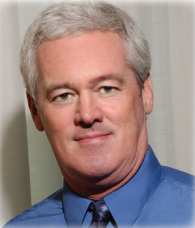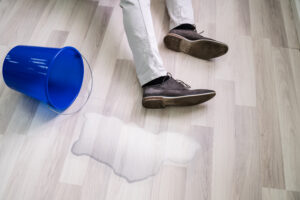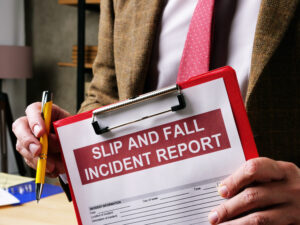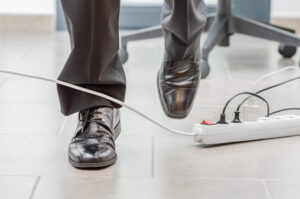By Mike Marinan, Director of Member Services – Public Risk Underwriters of Florida, Inc.

Slip and fall injuries are the most frequently reported workplace accidents. Falls are the primary cause of lost time at work, the average employee misses 11 days of work after a workplace fall, 22% of workplace falls result in more than 31 days of missed work.
Slips, trips and falls cost employers more than $17 billion a year. It is a serious problem and happens across all classifications. Within Preferred, slip, trip and falls consistently rank as the number two claim cause for both frequency and severity.
So what causes workplace trips and falls? Although categorized together they are separate incidents that can be addressed separately.
There are many things that can cause a person to slip and fall and not just the obvious spillage. The most common causes are:
- Wet Floors: Wet floors can be caused by a variety of things. Spillages are an obvious reason. Cleaning activities can create wet floor surfaces. If it’s raining outside, entrance ways can become wet as rain travels in off of people’s shoes and clothing. Poorly maintained buildings can leak.
- Slippery Floors: Glossy polished floor tiles can be a slip hazard if they are in an unsuitable place like a bathroom or entrance, where the floor may become wet. Depending on the type of footwear, flooring may be slippery even in dry conditions.
- Dusty Floors: It’s not just liquids that can cause slips. Dusty floor surfaces can also create a slip hazard.
- Loose Mats and Floor Coverings: Some mats can create a slip hazard if they are old or don’t grip well with the surface underneath. Step on it the wrong way and it can slide.
- Unsuitable Footwear: The slickness of the soles and the type of heels worn need to be evaluated to avoid slips and falls. Shoelaces need to be tied.
Trip hazards can happen in any type of work environment, and it’s not just cables you need to look out for. The most common causes are:
- Obstacles: Leaving materials, tools, boxes or equipment lying around, especially in or near walkways are a common cause of trips at work. In addition, not storing items on stairs.
- Loose Flooring: Loose floor coverings can be a slip hazard, they can also be a trip hazard. Rug curled up at the corner, a loose floorboard, frayed carpet.
- Uneven Flooring: Walking surfaces or sidewalks, potholes and uneven paving can also create trip hazards. Broken cracked slabs and other maintenance issues should be resolved as soon as possible.
- Trailing Cables: Electricity is everywhere, or at least we need it everywhere. Whatever it is usually needs to be plugged in and that cable can create a problem.
- Obstructions: Like obstacles, but obstructions are fixed rather that temporary. Low walls or curbs, a step that you didn’t know was there or floor mounted socket covers can all be a trip hazard.
- Poor Housekeeping: The leading cause of slips, trips and falls at work. Removing waste and cleaning up regularly can help lower the risk.
- Bad Lighting: Obstacles and obstructions are worse if you can’t see them. Good lightning can help identify hazards and get them removed.
The causes of and solutions for slips, trips and falls may seem obvious. Although many safety programs do a good job of addressing them, they continue to be a serious issue. To be certain that they are being adequately addressed and managed, your policies and procedures should include the following:
Regular Maintenance:
- Replace cracked, working or aged floor surfaces
- Ensure walkways are clear
- Use anti -slip cleaning products
- Make sure all areas are well-lit to make it easier to spot hazards
- Have a plan to clean spills or wet surfaces
Rules and Procedures:
- Encourage and make it easy to report spills
- Regularly inspect work areas to ensure they are in good order
- Provide instruction on the necessity for good housekeeping
Proper Equipment:
- Use high-traction mats
- Require the proper non-slip footwear
- Install handrails on stairs



There is one additional condition that contributes to slip, trip and falls and it may be the toughest to control, individual behavior. It’s human nature to let our guard down temporarily and be distracted by random thoughts or doing multiple activities.
Being in a hurry will result in walking too fast or running, which increases the chances of slip, trip or fall. Taking shortcuts, not watching where one is going, using a cell phone, carrying materials which obstruct the vision, wearing sunglasses in low-light areas, not using designated walkways and speed are common factors.
While most slips, trips and falls are avoidable it’s ultimately up to each individual to plan, stay alert and pay attention. Embracing a culture of safety within your organization will play a large part in your efforts to avoid these types of incidents which can injure employees and lead to increased claims costs.
Please contact your Preferred Loss Control Consultant to learn more about ways to help you and your organization prevent slips, trips and falls. There are many resources available including onsite and virtual inspections of premises.
Mike Marinan, Director of Member Services – Public Risk Underwriters of Florida, Inc. – Mike has a degree in Industrial Safety Engineering and over 37 years experience in the Safety and Risk Management field. He has been employed by Public Risk Underwriters of Florida, Inc. for 19 years. He holds an RMPE designation, holds a General Lines 220 and 218 licenses, is an active member of Central Florida PRIMA, as well as an active member of ASSP and numerous related Safety and Health organizations. He was a Governor appointee to the Task Force on Workplace Safety.

